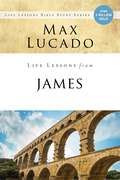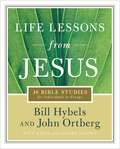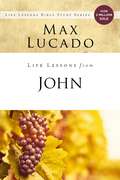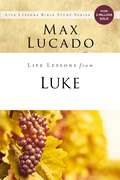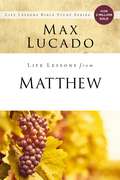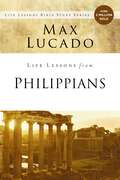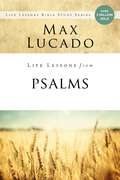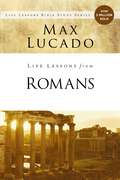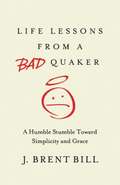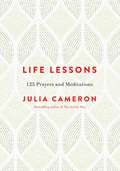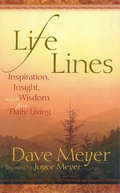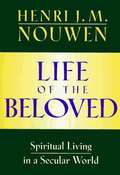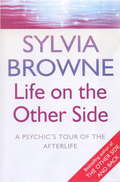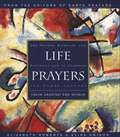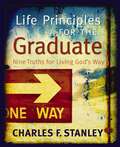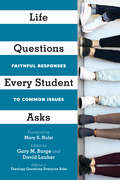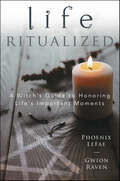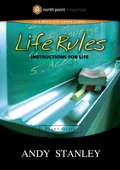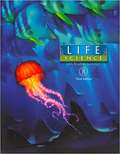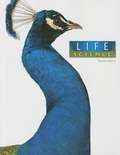- Table View
- List View
Life Lessons from James: Practical Wisdom (Life Lessons)
by Max LucadoOVER 2 MILLION SOLD IN THE LIFE LESSONS SERIES!Do your Monday actions reflect your Sunday worship? How about your claims to faith? Is your life full of noticeable changes and actions?James, the half-brother of Jesus, wasn't impressed with talk. He knew that a life of faith was all about actions that revealed a difference in a person's life. For him, it was not that works save the Christian, but that they mark the Christian. In his letter, he boldly deals with practical issues of faith not bound by culture or place. He shows the importance of living a genuine life of faith. His message is bare-knuckled as he encourages, challenges, and confronts, offering practical words and admonitions to live out our faith.As you read, study, journal, and discuss the book of James, watch for these key themes that Max will unpack throughout the book:God gives us true wisdom.Satan tempts to break us; God tests to strengthen us.The words we use are powerful and influential.Faith and good deeds go hand in hand. The Life Lessons with Max Lucado series brings the Bible to life in twelve lessons filled with intriguing questions, inspirational stories, and poignant reflections to take you deeper into God's Word. Each lesson includes:An opening reflection on the Bible book you're studying.Background information to deepen your understanding of the cultural and historical setting.An excerpt of the text (from the NIV and the NKJV).Exploration questions with plenty of room to write your own thoughts and notes.Inspirational thoughts from Max as well as a closing takeaway for further reflection. The Life Lessons series is ideal for use in both a small-group setting or for individual study.
Life Lessons from Jesus
by John Ortberg Bill Hybels Kevin HarneyWhen Jesus was walking the earth, everyone had a theory about who he was—healer, revolutionary, king, friend, humble carpenter. But out of the vast complexity of characteristics and ideas there emerges one simple word that no one can deny: “Rabbi.”These 36 Bible studies capture the heart of Jesus the Rabbi. He was a revolutionary, miracle-working, loving, powerful, divine teacher. For those whose minds are ready to be expanded, whose hearts are hungering to be touched, and whose lives are ripe for growth, John Ortberg and Bill Hybels invites people of all ages and backgrounds to pull up a chair and dig into the life lessons of Jesus captured in the Bible throughout the Gospels.Designed for use as personal Bible study or group study, the interactive format will help readers grow in their ability to reflect the character of Jesus.Studies include:Twelve Studies on the Sermon on the Mount by Bill HybelsSix Studies on The Lord’s Prayer by John OrtbergSix Studies on the Parables by John OrtbergSix Studies on The Passion Story by Bill HybelsSix Studies on Luke by Bill Hybels
Life Lessons from John: When God Became Man (Life Lessons)
by Max LucadoOVER 2 MILLION SOLD IN THE LIFE LESSONS SERIES!John had been there. With Jesus when he went among the people and loved them. And John could still hear the words: I am the light of the world...I am the door...I am the way, the truth, the life... So, when John wrote his account of Jesus' life, he wrote so that others may believe and have life in Jesus' name.Join beloved author Max Lucado as he opens John's Gospel to see through John's eyes this saving Son of Man. As you read, study, journal, and discuss the book of John, watch for these key themes that Max will unpack throughout the book:Jesus was and is eternally present in spirit.While Jesus was on earth, he communicated with many kinds of people about his mission.Jesus performed many miracles to show the nature of his love and power.Jesus prepared his followers for the future by promising them the presence of the Holy Spirit. The Life Lessons with Max Lucado series brings the Bible to life in twelve lessons filled with intriguing questions, inspirational stories, and poignant reflections to take you deeper into God's Word. Each lesson includes:An opening reflection on the Bible book you're studying.Background information to deepen your understanding of the cultural and historical setting.An excerpt of the text (from the NIV and the NKJV).Exploration questions with plenty of room to write your own thoughts and notes.Inspirational thoughts from Max as well as a closing takeaway for further reflection. The Life Lessons series is ideal for use in both a small-group setting or for individual study.
Life Lessons from Luke: Jesus, the Son of Man (Life Lessons)
by Max LucadoOVER 2 MILLION SOLD IN THE LIFE LESSONS SERIES!Nearly 2,000 years ago, a doctor named Luke wrote a letter in which he prioritized two things: a love for Christ and a love for the facts. He didn't want legends; he wanted truth. And so, Dr. Luke began to sort the truth and report the facts. The result is part letter, part research paper.Join beloved author Max Lucado as he studies Luke's Gospel and helps you rediscover those truths of Christ's life, authority, and ultimate love for His people. As you read, study, journal, and discuss the book of Acts, watch for these key themes that Max will unpack throughout the book:Jesus was fully man and fully God.Jesus experienced the conflicts of life, yet performed miracles.Jesus fulfilled God's mission and taught of God's kingdom.Jesus' death and resurrection made possible our relationship with God. The Life Lessons with Max Lucado series brings the Bible to life in twelve lessons filled with intriguing questions, inspirational stories, and poignant reflections to take you deeper into God's Word. Each lesson includes:An opening reflection on the Bible book you're studying.Background information to deepen your understanding of the cultural and historical setting.An excerpt of the text (from the NIV and the NKJV).Exploration questions with plenty of room to write your own thoughts and notes.Inspirational thoughts from Max as well as a closing takeaway for further reflection. The Life Lessons series is ideal for use in both a small-group setting or for individual study.
Life Lessons from Mark: A Life-Changing Story (Life Lessons)
by Max LucadoOVER 2 MILLION SOLD IN THE LIFE LESSONS SERIES!In the eighth chapter of Mark, Jesus looks at his disciples and asks them a very direct question: Who do you say that I am? You've probably been asked some important questions in your life. But the grandest of them is an anthill compared to the Everest of this question of Jesus'. He's asking us the same question today.Join beloved author Max Lucado as he opens Mark's Gospel and helps you discover how to respond to God's Living Word and step out in faith. As you read, study, journal, and discuss the book of Mark, watch for these key themes that Max will unpack throughout the book:Jesus was a savior and yet a servant.Jesus gave his life as a sacrifice for humanity's broken relationship with God.Jesus performed miracles through the power of God.Jesus taught about the kingdom of God. The Life Lessons with Max Lucado series brings the Bible to life in twelve lessons filled with intriguing questions, inspirational stories, and poignant reflections to take you deeper into God's Word. Each lesson includes:An opening reflection on the Bible book you're studying.Background information to deepen your understanding of the cultural and historical setting.An excerpt of the text (from the NIV and the NKJV).Exploration questions with plenty of room to write your own thoughts and notes.Inspirational thoughts from Max as well as a closing takeaway for further reflection. The Life Lessons series is ideal for use in both a small-group setting or for individual study.
Life Lessons from Matthew: The Carpenter King (Life Lessons)
by Max LucadoOVER 2 MILLION SOLD IN THE LIFE LESSONS SERIES!Matthew accepted Christ's invitation to follow him and never turned back. He spent the rest of his life convincing folks that this carpenter was the King.Jesus gave the call and never took it back. The relationship Jesus had with Matthew can serve to convince us that if Jesus had a place for Matthew, a tax collector, he just might have a place for us, too.Join beloved author Max Lucado as he enters Matthew's Gospel to find out what it looks like to be chosen by the Carpenter King—and what it looks like to accept his invitation. As you read, study, journal, and discuss the book of Matthew, watch for these key themes that Max will unpack throughout the book:God kept his promise of a deliverer for his people.God's ideas about his kingdom are often different from his people's ideas of the same kingdom.Jesus lived fully as a human and as God.Jesus' ministry and sacrifice changed the world forever. The Life Lessons with Max Lucado series brings the Bible to life in twelve lessons filled with intriguing questions, inspirational stories, and poignant reflections to take you deeper into God's Word. Each lesson includes:An opening reflection on the Bible book you're studying.Background information to deepen your understanding of the cultural and historical setting.An excerpt of the text (from the NIV and the NKJV).Exploration questions with plenty of room to write your own thoughts and notes.Inspirational thoughts from Max as well as a closing takeaway for further reflection. The Life Lessons series is ideal for use in both a small-group setting or for individual study.
Life Lessons from Philippians: Guide to Joy (Life Lessons)
by Max LucadoOVER 2 MILLION SOLD IN THE LIFE LESSONS SERIES!In an era marked by frustration, could you use more contentment? In a world filled with anxieties, worries, and fears, could you stand to have a bit more joy?The believers in Philippi were struggling. They were trying to grow in faith and live for Christ. Trying to deal with conflict and threats of persecution. The apostle Paul was stuck in a Roman prison when he wrote to this young church. His letter could have focused on his own troubles. Instead, he wrote about living a life full of joy, peace, and contentment.Paul's confidence reminds us of God's wisdom and control in the difficult moments of life. His excitement challenges us in this guide to joy. As you read, study, journal, and discuss the book of Philippians, watch for these key themes that Max will unpack throughout the book:By faith we have Christ in us because of the Spirit of God.Only Christ can bring salvation.Christian unity encourages our faith. The Life Lessons with Max Lucado series brings the Bible to life in twelve lessons filled with intriguing questions, inspirational stories, and poignant reflections to take you deeper into God's Word. Each lesson includes:An opening reflection on the Bible book you're studying.Background information to deepen your understanding of the cultural and historical setting.An excerpt of the text (from the NIV and the NKJV).Exploration questions with plenty of room to write your own thoughts and notes.Inspirational thoughts from Max as well as a closing takeaway for further reflection. The Life Lessons series is ideal for use in both a small-group setting or for individual study.
Life Lessons from Psalms: A Praise Book for God’s People (Life Lessons)
by Max LucadoOVER 2 MILLION SOLD IN THE LIFE LESSONS SERIES!Worship is a daunting but important part of discipleship. For that reason, God gave us the Psalms...This collection of hymns and petitions was written over a span of centuries, in many different settings, by kings such as David and Solomon and commoners like Asaph, Heman, and the sons of Korah. Some of the psalms are defiant; others are reverent. Some are meant to be sung; others are to be prayed. Some are intensely personal; others are communal. But all have one purpose—to help us express our hears to God.As you read, study, journal, and discuss the book of Psalms, watch for these key themes that Max will unpack throughout the book:God is worthy of all worship.God will defend his people against their enemies.Being in relationship with God is the key to all joy and security. The Life Lessons with Max Lucado series brings the Bible to life in twelve lessons filled with intriguing questions, inspirational stories, and poignant reflections to take you deeper into God's Word. Each lesson includes:An opening reflection on the Bible book you're studying.Background information to deepen your understanding of the cultural and historical setting.An excerpt of the text (from the NIV and the NKJV).Exploration questions with plenty of room to write your own thoughts and notes.Inspirational thoughts from Max as well as a closing takeaway for further reflection. The Life Lessons series is ideal for use in both a small-group setting or for individual study.
Life Lessons from Revelation: Final Curtain Call (Life Lessons)
by Max LucadoOVER 2 MILLION SOLD IN THE LIFE LESSONS SERIES!The end of the world… How do you react to that thought? Does it make you afraid or nervous? Excited? At peace? Or do you simply try not to think about it?The apostle John was privileged to preview the end of the world in a dream. While in exile on the island of Patmos, he experienced an amazing vision that gave him a glimpse of heaven. He saw the final battle between good and evil. He saw God's justice. He witnessed the assured victory for believers in Christ as all hell broke loose and all heaven came forth. He saw Jesus, born in a manger, now triumphant over Satan. John's description stretches our imagination, fuels our anticipation, and comforts us as we await the final curtain call.As you read, study, journal, and discuss the book of Revelation, watch for these key themes that Max will unpack throughout the book:God has a plan and a future for the world.God will be ultimately victorious over evil.There will be a final accounting for our faith and our lives.There is a better world in store. The Life Lessons with Max Lucado series brings the Bible to life in twelve lessons filled with intriguing questions, inspirational stories, and poignant reflections to take you deeper into God's Word. Each lesson includes:An opening reflection on the Bible book you're studying.Background information to deepen your understanding of the cultural and historical setting.An excerpt of the text (from the NIV and the NKJV).Exploration questions with plenty of room to write your own thoughts and notes.Inspirational thoughts from Max as well as a closing takeaway for further reflection. The Life Lessons series is ideal for use in both a small-group setting or for individual study.
Life Lessons from Romans: God's Big Picture (Life Lessons)
by Max LucadoOVER 2 MILLION SOLD IN THE LIFE LESSONS SERIES!Romans is a life-changing letter for those who admit they're on the wrong road. Romans provides the correct itinerary. Read it and take note. The ride home is one you won't want to miss...In this profound epistle, Paul explores all the wrong directions and takes us to the only right one. The wrong solutions are pleasure and pride, and the correct solution is Christ Jesus. Join beloved author Max Lucado as he dives into the book of Romans to consider in Paul's words everything from practical instruction for a growing church to the very core of the Christian faith.As you read, study, journal, and discuss the book of Romans, watch for these key themes that Max will unpack throughout the book:All people are in need of a relationship with God.God has prepared for that relationship through his own sacrifice.Faith is the requirement of that relationship.Forgiveness is available from God for anyone. The Life Lessons with Max Lucado series brings the Bible to life in twelve lessons filled with intriguing questions, inspirational stories, and poignant reflections to take you deeper into God's Word. Each lesson includes:An opening reflection on the Bible book you're studying.Background information to deepen your understanding of the cultural and historical setting.An excerpt of the text (from the NIV and the NKJV).Exploration questions with plenty of room to write your own thoughts and notes.Inspirational thoughts from Max as well as a closing takeaway for further reflection.The Life Lessons series is ideal for use in both a small-group setting or for individual study.
Life Lessons from a Bad Quaker: A Humble Stumble Toward Simplicity and Grace
by J. Brent BillOn quick observation, the Quaker lifestyle boasts peace, solitude, and simplicity—qualities that are attractive to any believer of any denomination or religion. Yet living a life of faith is not as simple as it may look. In fact, it’s often characterized more by the stumbles than the grace."When someone asks me what kind of Christian I am," says Quaker author J. Brent Bill, "I say I’m a bad one. I’ve got the belief part down pretty well, I think. It’s in the practice of my belief in everyday life where I often miss the mark." In Life Lessons from a Bad Quaker, a self-professed non-expert on faith invites readers on a joyful exploration of the faith journey—perfection not required. With whimsy, humor, and wisdom, Bill shows readers how to put faith into practice to achieve a life that is soulfully still yet active, simple yet satisfying, peaceful yet strong. For anyone who is bad at being good, this is an invitation to a pilgrimage toward a more meaningful and satisfying life . . . one step—or stumble—at a time.
Life Lessons: 125 Prayers and Meditations
by Julia CameronThis book of prayers and affirmations by bestselling author of The Artist's Way, Julia Cameron, is full of inspiration and encouragement. Beautifully packaged, these pocket prayers are perfect for carrying around or sharing as a gift.All too often we yearn for a more spiritual life but tell ourselves it's too difficult. But the smallest prayer is heard and answered. The simplest overture meets with a loving response. Each of the prayers in this book is a starting point. Taken collectively, they offer an approach to God that is powerful as well as simple. These prayers not only allow us to reach out to God, but they allow God to reach out to us. The book is called Life Lessons because each entry is a corrective to commonly held misconceptions of the divine. Like the postures assumed in hatha yoga, they stretch us gently. Through these prayers, we learn more of ourselves and the divine.
Life Lessons: 125 Prayers and Meditations
by Julia CameronIn her signature compassionate voice that has won over the hearts of millions, Julia Cameron offers a collection of inspiring and encouraging messages to help you notice the beauty of life, trust the unfolding of events and know that you being looked after and protected, no matter what is happening.All too often we yearn for a more spiritual life but tell ourselves it's too difficult. But the smallest prayer is heard and answered. The simplest overture meets with a loving response. Each of the prayers in this book is a starting point. Taken collectively, they offer an approach to the Divine that is powerful as well as simple. These prayers not only allow us to reach out to God, but they allow the Divine Energy to reach out to us.The book is called Life Lessons because each entry is a corrective to commonly held misconceptions of the divine. Like the postures assumed in hatha yoga, they stretch us gently. Through these prayers, we learn more of ourselves and the divine.
Life Lines: Inspiration, Insight, and Wisdom for Daily Living
by Dave MeyerFilled with encouraging and thought-provokingquotes and meditations, LIFE LINES combines practical advice and passages from Scripture to help readers grow in faith and overcome life's obstacles. LIFE LINES is a unique collection of inspiring quotes combined with short meditations and Scripture from the Bible. Each page features a wise, witty, or instructive saying, along with stories and illustrations and invaluable advice for everyday situations. Dave Meyer's thoughtful meditations will be treasured for their wisdom and practicality. A daily reference for inspiration and support, LIFE LINES can be meditated upon, incorporated into devotions, or simply cherished throughout the year. Each page will encourage readers to achieve their goals, face their fears, and become all that God has called them to be.
Life Makeover: Embrace the Bold, Beautiful, and Blessed You
by Dominique SachseHave you ever been so overwhelmed by responsibilities or other people&’s needs that you forgot to make time for yourself? They say beauty is only skin-deep, but there is power in embracing your outward beauty as the first step in living with internal boldness, confidence, and renewed joy.An outside-in approach to beauty isn&’t for other people&’s perception of you, but for your interpretation of yourself and how much you&’re willing to explore. Sachse has confirmed the unmistakable link between external appearance and self-confidence, and she wants to show you how to rekindle both. In the pages of this book, Sachse offers a vulnerable look into her own mistakes and imperfections and explains how making over her outward appearance resulted in a happier and healthier version of herself—emotionally, spiritually, and physically.Filled with confidence-boosting wisdom about cultivating rest and lifegiving hobbies, Sachse shows you:how making small changes to your outward appearance can be a pathway to building confidence and making other new transformations in your lifepractical tips about hair, makeup, and fashion from an expertthe benefits of taking bold risks – your life is too valuable to be left on autopilot how to analyze your past and see where you self-sabotaged, and look for traits that served you well and can serve you in the futureSachse knows no amount of makeup can compare to the look of a confident, classy, and kind woman, and that there&’s nothing like the glow that comes from inner beauty. It&’s time to discover—or rediscover—who you really are and live your life to the fullest.
Life Maps: Conversations on the Journey of Faith
by Sam Keen Jim FowlerLife experience from a Christian perspective.
Life Of The Beloved: Spiritual Living In A Secular World
by Henri J. M. NouwenInitially written for a Jewish friend, Life of the Beloved has become Henri Nouwen’s greatest legacy to Christians around the world. This sincere testimony of the power and invitation of Christ is indeed a great guide to a truly uplifting spiritual life in today’s world.
Life On The Other Side: A psychic's tour of the afterlife
by Sylvia BrowneIn Life on The Other Side, Sylvia Browne explains what happens when we die; what The Other Side looks like; who's waiting for us on The Other Side; how we spend out time on The Other Side; why and how we return from The Other Side. With her trademark warm and down-to-earth style, Sylvia Browne's insights into the afterlife are utterly compelling yet wonderfully reassuring. Sylvia looks over her lifelong career as a psychic, using past experiences, readings, hypnosis sessions and research to illustrate her findings about The Other Side. For the very first time, we are shown an unprecedented view of a peaceful place where our departed loved ones are patiently awaiting us - and where the next leg of our eternal journey will begin. This book is absolutely unforgettable!
Life Prayers
by Elizabeth RobertsAn eloquent anthology honoring the wonders and challenges of life on earth and celebrating the seasons of our lives. The mysteries and delights of life on earth are illuminated in this richly eclectic collection of poetry, wisdom, prayers, and blessings from thinkers and writers around the world. Here you will find the poetry of Hildgard of Bingen and Gary Snyder; the political wisdom of Nelson Mandela and Martin Luther King, Jr.; a treasury of women's prayers, classical verse from China and Japan; and beautiful chants and prayers by Native Americans. A joyous affirmation of the human journey in all its forms, in all its struggles and glories.
Life Principles for the Graduate: Nine Truths for Living God's Way
by Charles F. StanleyEquip our graduates for living in the real world!Graduates from high school and college move into a newer, higher level of independence, making decisions that will affect them for the rest of their lives. They need wisdom and guidance as they face the challenges that come with living in the world without becoming part of it. Life Principles for the Graduate provides nine biblical truths for living God's way as opposed to the world's way, creating greater opportunity to grow stronger in faith while learning to trust and fully believe His Word as truth.
Life Questions Every Student Asks: Faithful Responses to Common Issues
by Gary M. Burge David Lauber David Lauber, Gary M. BurgeWhat does it mean to be in community?How can I discern my vocation?How should I understand marriage and sex?How should I relate to money and power?What happens if I doubt my faith?How should I approach interfaith dialogue?
Life Ritualized: A Witch's Guide to Honoring Life's Important Moments
by Phoenix LeFae Gwion RavenMake Every Rite of Passage Sacred and MeaningfulDozens of group and solitary activities for ritualizing life's changesCommemorate the moments that shape who you are with this book of rituals designed for rites of passage, no matter how big or small. Drawing on almost thirty years of experience in Witchcraft and Paganism, Phoenix LeFae and Gwion Raven offer powerful activities to honor everything from getting a driver's license to starting a coven to retiring.Life Ritualized offers clear instructions and inspiring stories to deepen your spirituality. Whether it's a weighty occasion like birth, marriage, or death, or a more private one like blessing a new house or changing jobs, this book provides everything you need to make it a moment of reflection and reverence. These rituals create stronger connections between you and your loved ones, and they also strengthen your relationship with yourself. Featuring guidance on using correspondences and creating unique rites, Life Ritualized helps you celebrate the adventure of life.
Life Rules Study Guide: Instructions for the Game of Life
by Andy StanleyEverything You Need to Know in Life, You Can Learn Here! When we were in kindergarten, half the fun of living was breaking the rules without getting caught. In real adult life, however, there is nothing fun about broken promises, relationships, or hearts. In this DVD and study guide from North Point Resources, Andy Stanley explains God's set of life rules that can improve current relationships and mend broken ones. Every game requires parameters, and in this lifelong journey toward heaven, it's never too late to learn, relearn, and follow the rules God clearly outlines for His peoplehellip;because they set you on the course for success! Winners Play by the Rules In kindergarten, ignoring the rules was a blast-especially if you could get away with it. But as adults, we understand that rules are for our protection, and that when we break God's rules we cause heartache and broken relationships. Designed for small group or personal use, this companion study guide to theLife RulesDVD clearly explains God's basic set of life rules which, when lived, hold the power to improve all your relationships. It's never too late to learn and follow the parameters God clearly outlines for His people. This study guide is complete with a leader's guide and six lessons, including easy-to-do exercises and discussion questions. Story Behind the Book A new addition to the North Point Resources brand group from a series taught by Andy Stanley at North Point Community Church .
Life Science (3rd Edition): Volume A
by Brad R. Batdorf Thomas E. PorchLIFE SCIENCE, 3rd ed., is a middle-school textbook written by people who believe the Bible is the Word of God. Those who do not believe that the Bible is true will find many points in this book puzzling. As we begin this course, let us define what the course is. Science can be defined as man's observations of the world God created and man's use of those observations to make decisions. Life science is observations and decisions about living things. In a life science course, you should learn about the observations other people have made of living things. You should also develop the skills necessary to make good observations on your own. Finally, in a Christian life science course, you should learn what God has said about life and living things. You should learn the principles He has given to direct our decision making about living things. God has given us senses that enable us to explore our world and minds to analyze our observations. Over the centuries, scientists have developed an organized process for making decisions about the world. This scientific method is a powerful and valuable tool, but like all tools it is hindered by human limitations and shortcomings.
